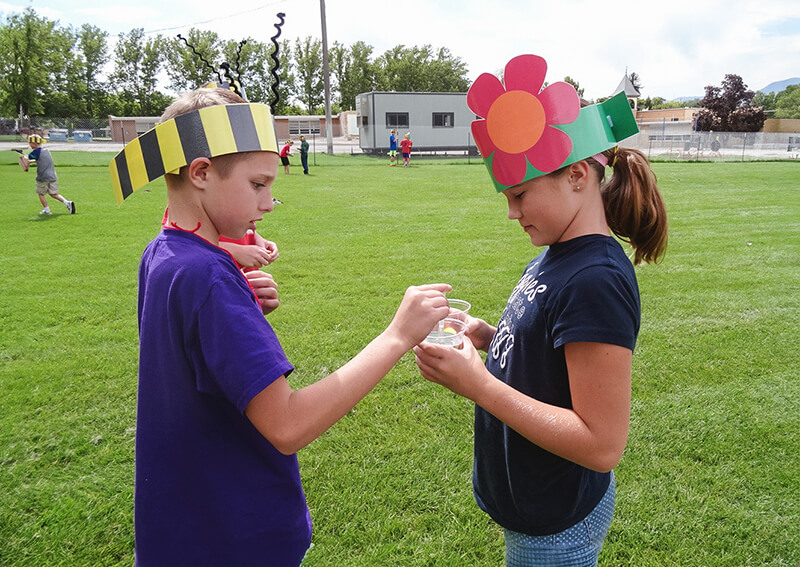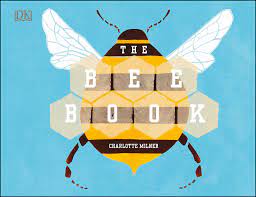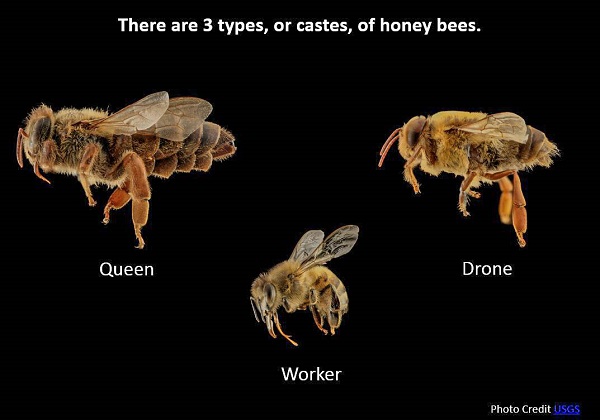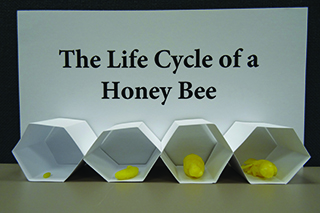Honey Bees: A Pollination Simulation
Students identify the parts of a honey bee, the stages of its life cycle, and its role in pollination.

Background
Lesson Activities
Recommended Companion Resources
Credits
Author
Lynn Wallin | Utah Agriculture in the Classroom
Standards
Texas Content Area Standards
-
ELA: 3.110.5.b.4
Developing and sustaining foundational language skills: listening, speaking, reading, writing, and thinking- fluency. The students reads grade-level text with fluency and comprehension. The student is expected to use appropriate fluency (rate, accuracy, and prosody) when reading grade-level text.
- ELA: 3.4 : Developing and sustaining foundational language skills: listening, speaking, reading, writing, and thinking -fluency. The student reads grade-level text with fluency and comprehension. The student is expected to use appropriate fluency (rate, accuracy, and prosody) when reading grade-level text.
-
ELA: 3.110.5.b.6
Comprehension skills: listening speaking, reading, writing and thinking using multiple texts. The student uses metacognitive skills to both develop and deepen comprehension of increasingly complex texts.
- ELA: 3.6.G: The student is expected to evaluate details read to determine key ideas.
- ELA: 3.6.H: The student is expected to synthesize information to create new understanding.
- ELA: 3.110.5.b.6.A: establish purpose for reading assigned and self-selected texts
- ELA: 3.110.5.b.6.H: synthesize information to create new understanding
-
ELA: 4.110.6.b.1
Developing and sustaining foundational language skills: listening, speaking, discussion, and thinking- oral language. The students develops oral language through listening, speaking, and discussion.
- ELA: 4.1.A: The student is expected to listen actively, ask relevant questions to clarify information, and make pertinent comments.
- ELA: 4.110.6.b.1.D: work collaboratively with others to develop a plan of shared responsibilities
-
ELA: 4.110.6.b.4
Developing and sustaining foundational language skills: listening, speaking, reading, writing, and thinking- fluency. The students reads grade-level text with fluency and comprehension. The student is expected to use appropriate fluency (rate, accuracy, and prosody) when reading grade-level text.
- ELA: 4.b.4: Developing and sustaining foundational language skills: listening, speaking, reading, writing, and thinking- fluency. The students reads grade-level text with fluency and comprehension. The student is expected to use appropriate fluency (rate, accuracy, and prosody) when reading grade-level text.
-
ELA: 4.110.6.b.6
Comprehension skills: listening, speaking, reading, writing and thinking using multiple texts. The student uses metacognitive skills to both develop and deepen comprehension of increasingly complex texts.
- ELA: 4.6.A: The student is expected to establish purpose for reading assigned and self-selected texts.
- ELA: 4.6.E: The student is expected to make connections to personal experiences, ideas in other texts, and society.
- ELA: 4.6.G: The student is expected to evaluate details read to determine key ideas.
- ELA: 4.6.H: The student is expected to synthesize information to create new understanding.
- ELA: 4.110.6.b.6.H: synthesize information to create new understanding
-
ELA: 4.110.6.b.7
Response skills: listening, speaking, reading, writing, and thinking using multiple texts. The student responds to an increasingly challenging variety of sources that are read, heard, or viewed.
- ELA: 4.7.G: The student is expected to discuss specific ideas in the text that are important to the meaning.
-
ELA: 5.110.7.b.4
Developing and sustaining foundational language skills: listening, speaking, reading, writing, and thinking- fluency. The students reads grade-level text with fluency and comprehension. The student is expected to use appropriate fluency (rate, accuracy, and prosody) when reading grade-level text.
- ELA: 5.b.4: Developing and sustaining foundational language skills: listening, speaking, reading, writing, and thinking- fluency. The students reads grade-level text with fluency and comprehension. The student is expected to use appropriate fluency (rate, accuracy, and prosody) when reading grade-level text.
-
ELA: 5.110.7.b.6
Comprehension skills: listening, speaking, reading, writing, and thinking using multiple texts. The student uses metacognitive skills to both develop and deepen comprehension of increasingly complex texts.
- ELA: 5.6.A: establish purpose for reading assigned and self-selected texts
- ELA: 5.6.H: The student is expected to synthesize information to create new understanding.
- ELA: 5.110.7.b.6.H: synthesize information to create new understanding
-
ELA: 5.110.7.b.7
Response skills: listening, speaking, reading, writing, and thinking using multiple texts. The student responds to an increasingly challenging variety of sources that are read, heard, or viewed.
- ELA: 5.7.E: The student is expected to interact with sources in meaningful ways such as notetaking, annotating, freewriting, or illustrating.
- ELA: 5.7.G: The student is expected to discuss specific ideas in the text that are important to the meaning.
-
Social Studies: 3.113.14.c.4
Geography. The student understands the concepts of location, distance, and direction on maps and globes. The student is expected to:
- Social Studies: 3.113.14.c.14.D: interpret and create visuals, including graphs, charts, tables, timelines, illustrations, and maps
-
Science: 3.112.14.b.9
Organisms and environments. The student knows and can describe patterns, cycles, systems, and relationships within the environments.
- Science: 3.112.14.b.9.A: The student is expected to observe and describe the physical characteristics of environments and how they support populations and communities of plants and animals within an ecosystem.
- Science: 3.112.14.b.9.B: identify and describe the physical characteristics of environments and how they support populations and communities of plants and animals within an ecosystem
-
Science: 3.112.14.b.10
Organisms and environments. The student knows that organisms undergo similar life processes and have structures that help them survive within their environments.
- Science: 3.112.14.b.10.A: The student is expected to explore how structures and functions of plants and animals allow them to survive in a particular environment.
-
Science: 4.112.15.b.10
Organisms and environments. The student knows that organisms undergo similar life processes and have structures and behaviors that help them survive within their environment.
- Science: 4.10.A: The student is expected to explore how structures and functions enable organisms to survive in their environment.
-
Science: 5.112.16.b.9
Organisms and environments. The student know s that there are relationships, systems, and cycles within environments.
- Science: 5.9.A: The student is expected to observe the way organisms live and survive in their ecosystems by interacting with the living and nonliving components.
-
Social Studies: 3.113.14.c.14
Social studies skills. The student applies critical-thinking skills to organize and use information acquired from a variety of valid sources, including technology. The student is expected to:
- Social Studies: 3.113.14.c.14.C: interpret oral, visual, and print material by sequencing, categorizing, identifying the main idea, distinguishing between fact and opinion, identifying cause and effect, comparing, and contrasting
-
Social Studies: 3.113.14.c.16
Social studies skills. The student uses problem-solving and decision-making skills, working independently and with others. The student is expected to:
- Social Studies: 3.113.14.c.16.B: use problem-solving and decision-making processes to identify a problem, gather information, list and consider options, consider advantages and disadvantages, choose and implement a solution, and evaluate the effectiveness of the solution
-
Social Studies: 4.113.15.c.19
Social studies skills. The student applies critical-thinking skills to organize and use information acquired from a variety of valid sources, including technology. The student is expected to:
- Social Studies: 4.113.15.c.19.C: analyze information by applying absolute and relative chronology through sequencing, categorizing, identifying cause-and-effect relationships, comparing, contrasting, finding the main idea, summarizing, making generalizations and predictions, and drawing inferences and conclusions;
- Social Studies: 4.113.15.c.19.D: organize and interpret information in outlines, reports, databases, and visuals, including graphs, charts, timelines, and maps
-
Social Studies: 4.113.15.c.21
Social studies skills. The student communicates in written, oral, and visual forms. The student is expected to:
- Social Studies: 4.113.15.c.21.D: create written and visual material such as journal entries, reports, graphic organizers, outlines, and bibliographies
-
Social Studies: 4.113.15.c.22
Social studies skills. The student uses problem-solving and decision-making skills, working independently and with others. The student is expected to:
- Social Studies: 4.113.15.c.22.B: use problem-solving and decision-making processes to identify a problem, gather information, list and consider options, consider advantages and disadvantages, choose and implement a solution, and evaluate the effectiveness of the solution
-
Social Studies: 5.113.16.c.23
Social studies skills. The student applies critical-thinking skills to organize and use information acquired from a variety of valid sources, including technology. The student is expected to:
- Social Studies: 5.113.16.c.23.C: analyze information by applying absolute and relative chronology through sequencing, categorizing, identifying cause-and-effect relationships, comparing, contrasting, finding the main idea, summarizing, making generalizations and predictions, and drawing inferences and conclusions
- Social Studies: 5.113.16.c.23.D: organize and interpret information in outlines, reports, databases, and visuals, including graphs, charts, timelines, and maps
-
Social Studies: 5.113.16.c.25
Social studies skills. The student communicates in written, oral, and visual forms. The student is expected to:
- Social Studies: 5.113.16.c.25.D: create written and visual material such as journal entries, reports, graphic organizers, outlines, and bibliographies
-
Social Studies: 5.113.16.c.26
Social studies skills. The student uses problem-solving and decision-making skills, working independently and with others. The student is expected to:
- Social Studies: 5.113.16.c.26.B: use problem-solving and decision-making processes to identify a problem, gather information, list and consider options, consider advantages and disadvantages, choose and implement a solution, and evaluate the effectiveness of the solution
-
Science: 3.112.5.b.1
Scientific and engineering practices. The student asks questions, identifies problems, and plans and safely conducts classroom, laboratory, and field investigations to answer questions, explain phenomena, or design solutions using appropriate tools and models. The student is expected to:
- Science: 3.112.5.b.1.A: ask questions and define problems based on observations or information from text, phenomena, models, or investigations
- Science: 3.112.5.b.1.C: demonstrate safe practices and the use of safety equipment during classroom and field investigations as outlined in Texas Education Agency-approved safety standards
-
Science: 3.112.5.b.2
Scientific and engineering practices. The student analyzes and interprets data to derive meaning, identify features and patterns, and discover relationships or correlations to develop evidence-based arguments or evaluate designs. The student is expected to:
- Science: 3.112.5.b.2.A: identify advantages and limitations of models such as their size, properties, and material
- Science: 3.112.5.b.2.C: use mathematical calculations to compare patterns and relationships
-
Science: 3.112.5.b.3
Scientific and engineering practices. The student develops evidence-based explanations and communicates findings, conclusions, and proposed solutions. The student is expected to:
- Science: 3.112.5.b.3.B: communicate explanations and solutions individually and collaboratively in a variety of settings and formats
-
Science: 3.112.5.b.5
Recurring themes and concepts. The student understands that recurring themes and concepts provide a framework for making connections across disciplines. The student is expected to:
- Science: 3.112.5.b.5.A: identify and use patterns to explain scientific phenomena or to design solutions
- Science: 3.112.5.b.5.D: examine and model the parts of a system and their interdependence in the function of the system
- Science: 3.112.5.b.5.G: explain how factors or conditions impact stability and change in objects, organisms, and systems
-
Science: 3.112.5.b.12
Organisms and environments. The student describes patterns, cycles, systems, and relationships within environments. The student is expected to:
- Science: 3.112.5.b.12.A: explain how temperature and precipitation affect animal growth and behavior through migration and hibernation and plant responses through dormancy
- Science: 3.112.5.b.12.B: identify and describe the flow of energy in a food chain and predict how changes in a food chain such as removal of frogs from a pond or bees from a field affect the ecosystem
-
Science: 3.112.5.b.13
Organisms and environments. The student knows that organisms undergo similar life processes and have structures that function to help them survive within their environments. The student is expected to:
- Science: 3.112.5.b.13.A: explore and explain how external structures and functions of animals such as the neck of a giraffe or webbed feet on a duck enable them to survive in their environment
- Science: 3.112.5.b.13.B: explore, illustrate, and compare life cycles in organisms such as beetles, crickets, radishes, or lima beans
-
Science: 4.112.6.b.1
Scientific and engineering practices. The student asks questions, identifies problems, and plans and safely conducts classroom, laboratory, and field investigations to answer questions, explain phenomena, or design solutions using appropriate tools and models. The student is expected to:
- Science: 4.112.6.b.1.A: ask questions and define problems based on observations or information from text, phenomena, models, or investigations
- Science: 4.112.6.b.1.C: demonstrate safe practices and the use of safety equipment during classroom and field investigations as outlined in Texas Education Agency-approved safety standards
-
Science: 4.112.6.b.2
Scientific and engineering practices. The student analyzes and interprets data to derive meaning, identify features and patterns, and discover relationships or correlations to develop evidence-based arguments or evaluate designs. The student is expected to:
- Science: 4.112.6.b.2.C: use mathematical calculations to compare patterns and relationships
-
Science: 4.112.6.b.3
Scientific and engineering practices. The student develops evidence-based explanations and communicates findings, conclusions, and proposed solutions. The student is expected to:
- Science: 4.112.6.b.3.A: develop explanations and propose solutions supported by data and models
- Science: 4.112.6.b.3.B: communicate explanations and solutions individually and collaboratively in a variety of settings and formats
-
Science: 4.112.6.b.5
Recurring themes and concepts. The student understands that recurring themes and concepts provide a framework for making connections across disciplines. The student is expected to:
- Science: 4.112.6.b.5.A: identify and use patterns to explain scientific phenomena or to design solutions
- Science: 4.112.6.b.5.D: examine and model the parts of a system and their interdependence in the function of the system
-
Science: 4.112.6.b.11
Earth and space. The student understands how natural resources are important and can be managed. The student is expected to:
- Science: 4.112.6.b.11.A: identify and explain advantages and disadvantages of using Earth's renewable and nonrenewable natural resources such as wind, water, sunlight, plants, animals, coal, oil, and natural gas
-
Science: 4.112.6.b.12
Organisms and environments. The student describes patterns, cycles, systems, and relationships within environments. The student is expected to:
- Science: 4.112.6.b.12.B: describe the cycling of matter and flow of energy through food webs, including the roles of the Sun, producers, consumers, and decomposers
-
Science: 4.112.6.b.13
Organisms and environments. The student knows that organisms undergo similar life processes and have structures that function to help them survive within their environments. The student is expected to:
- Science: 4.112.6.b.13.A: explore and explain how structures and functions of plants such as waxy leaves and deep roots enable them to survive in their environment
-
Science: 5.112.7.b.1
Scientific and engineering practices. The student asks questions, identifies problems, and plans and safely conducts classroom, laboratory, and field investigations to answer questions, explain phenomena, or design solutions using appropriate tools and models. The student is expected to:
- Science: 5.112.7.b.1.A: ask questions and define problems based on observations or information from text, phenomena, models, or investigations
- Science: 5.112.7.b.1.C: demonstrate safe practices and the use of safety equipment during classroom and field investigations as outlined in Texas Education Agency-approved safety standards
-
Science: 5.112.7.b.2
Scientific and engineering practices. The student analyzes and interprets data to derive meaning, identify features and patterns, and discover relationships or correlations to develop evidence-based arguments or evaluate designs. The student is expected to:
- Science: 5.112.7.b.2.C: use mathematical calculations to compare patterns and relationships
-
Science: 5.112.7.b.3
Scientific and engineering practices. The student develops evidence-based explanations and communicates findings, conclusions, and proposed solutions. The student is expected to:
- Science: 5.112.7.b.3.A: develop explanations and propose solutions supported by data and models
- Science: 5.112.7.b.3.B: communicate explanations and solutions individually and collaboratively in a variety of settings and formats
-
Science: 5.112.7.b.5
Recurring themes and concepts. The student understands that recurring themes and concepts provide a framework for making connections across disciplines. The student is expected to:
- Science: 5.112.7.b.5.A: identify and use patterns to explain scientific phenomena or to design solutions
- Science: 5.112.7.b.5.D: examine and model the parts of a system and their interdependence in the function of the system
-
Science: 5.112.7.b.12
Organisms and environments. The student describes patterns, cycles, systems, and relationships within environments. The student is expected to:
- Science: 5.112.7.b.12.C: describe a healthy ecosystem and how human activities can be beneficial or harmful to an ecosystem
-
Science: 5.112.7.b.13
Organisms and environments. The student knows that organisms undergo similar life processes and have structures and behaviors that help them survive within their environments. The student is expected to:
- Science: 5.112.7.b.13.A: analyze the structures and functions of different species to identify how organisms survive in the same environment
-
ELA: 3.110.5.b.1
Developing and sustaining foundational language skills: listening, speaking, discussion, and thinking--oral language. The student develops oral language through listening, speaking, and discussion. The student is expected to:
- ELA: 3.110.5.b.1.D: work collaboratively with others by following agreed-upon rules, norms, and protocols
-
ELA: 5.110.7.b.1
Developing and sustaining foundational language skills: listening, speaking, discussion, and thinking--oral language. The student develops oral language through listening, speaking, and discussion. The student is expected to:
- ELA: 5.110.7.b.1.D: work collaboratively with others to develop a plan of shared responsibilities


